The ![]() DFS/DAA node accesses a parameter pane that is divided into two parts: parameter settings at the top and the trial-list setting table at the bottom.
DFS/DAA node accesses a parameter pane that is divided into two parts: parameter settings at the top and the trial-list setting table at the bottom.
Choices: DFS | DAA
Default: DFS
Coupling: When DAA is selected, the Standards of Radar Profiles will be coupled to ETSI 102 754.
Select the type of the radar profiles.
DFS is the radar profiles for Dynamic Frequency Selection.
DAA is the radar profiles for Detect And Avoid.
Depending on your selection, either DFS or DAA appears as a node in the tree view with its selected radar standard as a sub node.
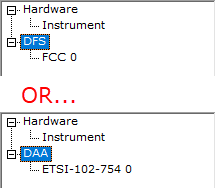
Enter the name of the sequence file to be played on the signal generator.
Enter an alpha-numeric comment up to 32 characters in length. The comment resides in the file header and can include spaces and special characters.
Range:the minimum value is 10 MHz and the maximum value depends on the supported maximum sample rate of the connected instrument.
Default: 10 MHz
Couplings:
Enter the sample rate used to generate the waveform.
Range: -1 to 2147483647
Default: 99991
Couplings: With the same seed, the Random Number Generator (RNG) generates the same random values. When the seed is -1, System Time will be used as the seed of RNG. Then the generated trial list will be different at different time.
The seed is the initial state of a Random Number Generator (RNG), which is used to generate a random value within the predefined range for parameters such as pulse width, PRI, or number of pulses for each trial , as shown in the table below (FCC radar types).
|
Radar Type |
Pulse Width (μs) | Pulse Repetition Interval PRI (μs) | Number of Pulses | Minimum Number of Trials |
|---|---|---|---|---|
|
1 |
1 | 1428 | 18 | 30 |
|
2 |
1~5 | 150~230 | 23~29 | 30 |
|
3 |
6~10 | 200~500 | 16~18 | 30 |
|
4 |
11~20 | 200~500 | 12~16 | 30 |
Choice: FCC| ETSI 301 893 | ETSI 302 502 | Japan MIC | Korea | China
Default:
Couplings: In the tree view of the display, the node under
Select a radar profile. A variety of organizations proposed their own
FCC is the organization based in the USA
ETSI is the organization based in Europe
ETSI 301 893 is the standard for DFS 5.3 GHz and 5.6 GHz
ETSI 302 502 is the standard for DFS 5.8 GHz
Japan MIC is a Japanese government organization
Korea is Korean DFS standards
China is Chinese DFS standards
Choices: FCC-06-96 | FCC-13-22
Default: FCC-06-96
Couplings:This cell is only visible when the Standards of Radar Profiles is selected to be FCC.
Select the version of FCC standard to be used for a specific radar profiles. Refer to FCC 06-96 and FCC 13-22 for more details about the definition of the radar profiles.
Couplings: This cell is only visible when the Standards of Radar Profiles is selected to be ETSI 301 893 or ETSI 302 502.
Display the version of standard to be used for ETSI Radar Profiles. Refer to ETSI 301 893 and ETSI 302 502 for more details about the definition of the radar profiles.
Choices: Fixed Frequency | Frequency Hopping
Default: Fixed Frequency
Couplings: This cell is only visible when the Standards of Radar Profiles is set to ETSI 302 502.
Select the radar frequency mode to be used for ETSI 302 502. Refer to ETSI 302 502 Radar Profiles for more details.
Choices: Others | 5600 MHz to 5650 MHz
Default: Others
Couplings: This cell is only visible when the Standards of Radar Profiles is selected to be ETSI 301 893.
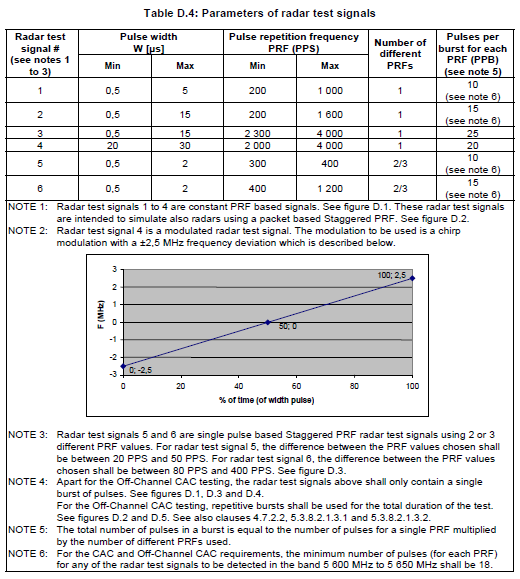
Source: ETSI EN 301 893 v1.7.1
Set the Operating Frequency Band to 5600 MHz to 5650 MHz when making CAC and Off-Channel CAC requirements test in 5600 MHz to 5650 MHz band. For other test cases, set Operating Frequency Band to Others.
Choice: ETSI 102 754
Default:
Couplings: In the tree view of the display, the node under
Select a radar profile. A variety of organizations proposed their own
ETSI is the organization based in Europe
ETSI 102 754 is the standard for DAA
Couplings: This cell is only visible when the Standards of Radar Profiles is selected to be ETSI 102 754.
Display the version of standard to be used for ETSI Radar Profiles. Refer DAA Concepts for more details about the definition of the radar profiles.
Choices: Waveform Start| Burst Start| Pulses| Waveform End| None
Default: Waveform Start
Select the marker points for Marker 1.
Waveform Start indicates the beginning of the radar signal.
Burst Start indicates the beginning of each burst inside of the radar signal.
Pulses controls the RF Blanking, and is used to do the pulse modulation. It’s the envelop of radar signal.
Waveform End indicates the end of radar signal.
Choices: Waveform Start| Burst Start| Pulses| Waveform End| None
Default: Burst Start
Select the marker points for Marker 2.
Waveform Start indicates the beginning of the radar signal.
Burst Start indicates the beginning of each burst inside of the radar signal.
Pulses controls the RF Blanking, and is used to do the pulse modulation. It’s the envelop of radar signal.
Waveform End indicates the end of radar signal.
This cell is read-only. It is set to Pulses and used for RF blanking control.
Choices: Waveform Start| Burst Start| Pulses| Waveform End| None
Default: Waveform End
Select the marker points for Marker 4.
Waveform Start indicates the beginning of the radar signal.
Burst Start indicates the beginning of each burst inside of the radar signal.
Pulses controls the RF Blanking, and is used to do the pulse modulation. It’s the envelop of radar signal.
Waveform End indicates the end of radar signal.
All the standards of radar profiles allow mixed trials with different radar types insides their own standards.
Click  button to add a new radar profile to the table.You can add a maximum of seven profiles and the new one is always added to the last row of the table. After you add a new radar profile, there will be a new node under DFS node to set the corresponding parameters in the tree view.
button to add a new radar profile to the table.You can add a maximum of seven profiles and the new one is always added to the last row of the table. After you add a new radar profile, there will be a new node under DFS node to set the corresponding parameters in the tree view.
Click  button to remove the selected profile in the list.
button to remove the selected profile in the list.

The parameters for each standards of radar profiles are different, as shown in the table below. For the detailed descriptions of each parameter, go to the corresponding node under the current DFS node.
FCC | ETSI 301 893 | ETSI 302 502 | Japan MIC | Korea | China |
|---|---|---|---|---|---|
Trial IDs | Trial IDs | Trial IDs | Trial IDs | Trial IDs | Trial IDs |
Radar Type | Radar Type | Radar Type | Radar Type | Radar Type | Radar Type |
Number of Trials | Number of Trials | Number of Trials | Number of Trials | Number of Trials | Number of Trials |
Interval Between Trials | Number of Bursts | Interval Between Trials | Interval Between Trials | Interval Between Trials | Number of Bursts |
| Interval Between Bursts* |
|
|
| Interval Between Bursts |
Interval Between Trials |
| Interval Between Trials |
* Available only when Variable Burst Interval Time is set to False.
FCC allows mixed trials of different Radar Types by adding or removing FCC profiles in the trial list setting table. Note that only type 0 ~ type 4 signals can be mixed.
A set of parameters are provided for each FCC profile to allow a configuration. These parameters can also be set by accessing the corresponding FCC node on the left panel of the UI. In addition to these parameters, the node also offers more detailed information about the profile.
If a radar type, which is not allowed for mixture, is selected, a window will be displayed to let you choose what to do. For example:
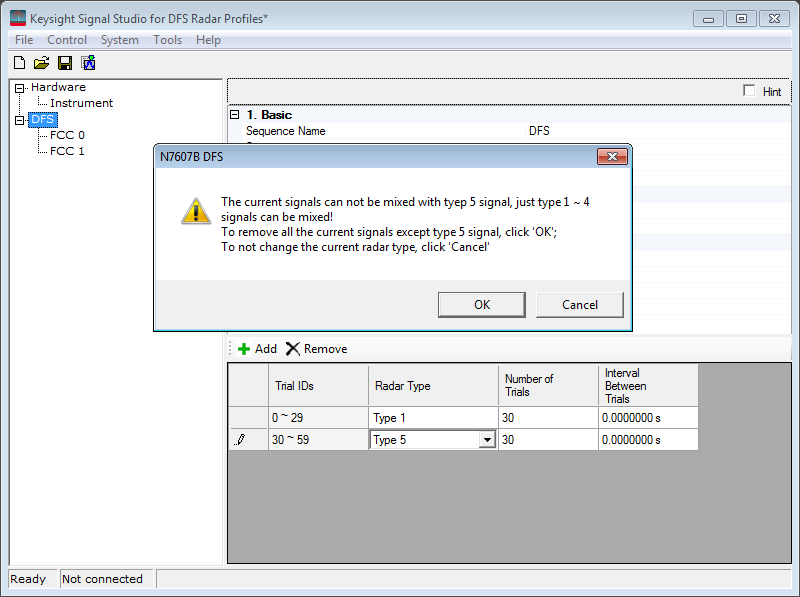
You can choose to remove all other type of signals except the selected one by clicking “OK”, or to not change the selected radar type by clicking “Cancel”.
ETSI 301 893 allows mixed trials of different Radar Types by adding or removing ETSI 301 893 profiles in the trial list setting table.
A set of parameters are provided for each ETSI 301 893 profile to allow a configuration. These parameters can also be set by accessing the corresponding ETSI 301 893 node on the left pane of UI. In addition to these parameters, the node also offers more detailed information about the profile.
ETSI 302 502 allows mixed trials of different Radar Types by adding or removing ETSI 302 502 profiles in the trial list setting table.
A set of parameters are provided for each ETSI 302 502 profile to allow a configuration. These parameters can also be set by accessing the corresponding ETSI 302 502 node on the left pane of UI. In addition to these parameters, the node also offers more detailed information about the profile.
Japan MIC allows mixed trials of different Radar Types by adding or removing Japan MIC profiles in the trial list setting table. Note that only W53/56 fixed and variable pulse signals can be mixed. W56 Chirp and W56 Hopping signals cannot be mixed with other signals.
A set of parameters are provided for each Japan MIC profile to allow a configuration. These parameters can also be set by accessing the corresponding Japan MIC node on the left pane of UI. In addition to these parameters, the node also offers more detailed information about the profile.
If a radar type which is not allowed for mixture is selected, a window will be displayed to let you choose what to do. For example:
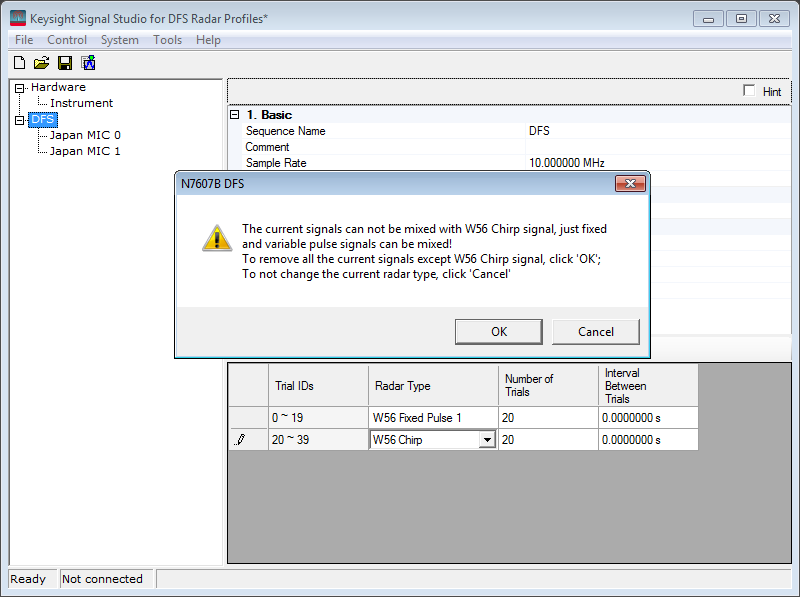
You can choose to remove all other type of signals except the selected one by clicking “OK”, or to not change the selected radar type by clicking “Cancel”.
Korea standard allows mixed trials of different Radar Types by adding or removing Korea profiles in the trial list setting table. Note that only type 1 to type 3 signals can be mixed. Type 4 signal cannot be mixed with others.
A set of parameters are provided for each Korea profile to allow a configuration. These parameters can also be set by accessing the corresponding Korea node on the left pane of UI. In addition to these parameters, the node also offers more detailed information about the profile.
If a radar type that is not allowed for mixture is selected, a window will be displayed to let you choose what to do. For example:
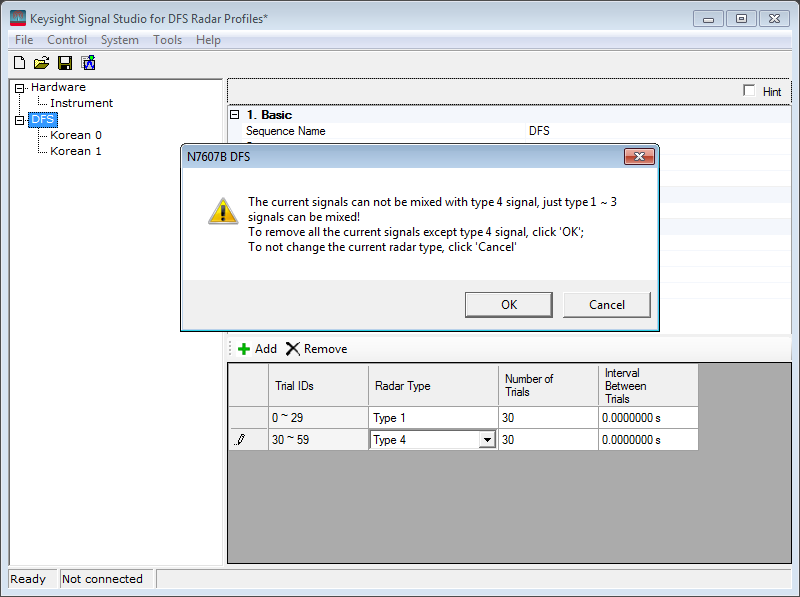
You can choose to remove all other type of signals except the selected one by clicking “OK”, or to not change the selected radar type by clicking “Cancel”.
China standard allows mixed trials of different Radar Types by adding or removing China profiles in the trial list setting table. Different radar types can be mixed.
A set of parameters are provided for each China profile to allow a configuration. These parameters can also be set by accessing the corresponding China node on the left pane of UI. In addition to these parameters, the node also offers more detailed information about the profile.